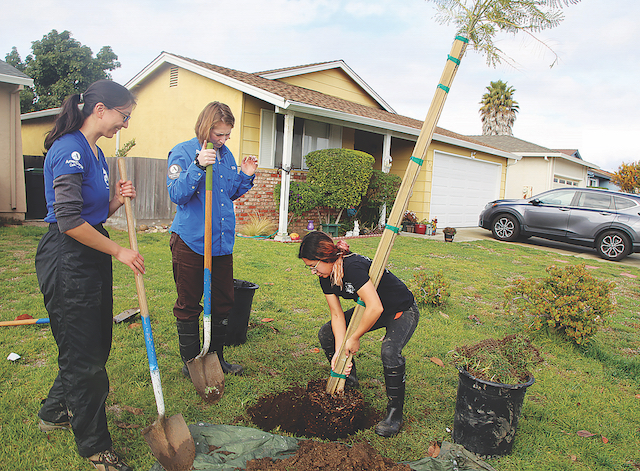
In 2017, Watsonville Wetlands Watch (WWW) and the City of Watsonville received a joint grant from the California Department of Fire and Forestry and the California Climate Investment Program. This boost of funding helped form WWW’s Forest and Climate Resiliency program, kickstarting a citywide tree planting effort.
As of December 2022, the program has helped plant 1,100 trees in both residential and commercial areas of Watsonville, and several other organizations and local private family foundations have contributed to funding the effort.
Now, WWW is encouraging residents and businesses to take advantage of their Adopt a Tree program, which offers free shade trees to local residents and businesses.
Jonathan Pilch, executive director of WWW, said there were two main factors that led them to lead the tree planting effort.
“The first was climate resiliency,” he said. “Here in Watsonville, we have less than 9% tree canopy. Our goal is to have 30, because of all the benefits it provides: air and water improvement, carbon sequestration and capture, and resilience to extreme heat days–shading and cooling of the city.”
The unique wetlands habitats that flow through the Pajaro Valley are another driving force.
“Our desire is to grow tree canopy in a way that is complementary to this long-term environmental restoration effort that has been going on in the community for the past few decades,” Pilch said. “We want our urban forest and wetlands to go hand-in-hand.”
The free tree program began with WWW planting in parks and other public spaces. But most of the available land to plant is actually on private residences, Pilch said.
“If we really want to increase the amount of shade on sidewalks, the best way to do that is to have as many people as possible adopt and plant trees,” he said. “Planting within sidewalks is complicated and hard, but planting trees that benefit sidewalks and streets, in more open spaces like yards is ideal.”
WWW is offering more than 25 different shade tree types of different sizes, including evergreens, deciduous and some that flower. This includes native trees and non-invasive varieties from other regions. All trees offered are drought tolerant.
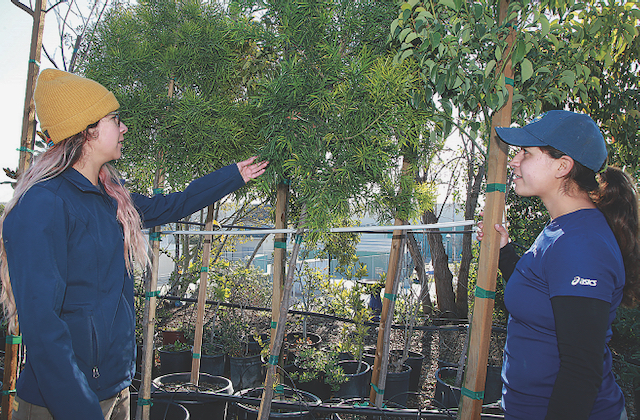
Residents and business owners can fill out a form or call WWW to schedule an onsite visit, where the organization surveys the property and calls 811 to check for underground utilities. They will then make a recommendation to the property owner about what kind of tree would be suitable.
Once a tree is chosen, WWW offers planting assistance, and provides stakes, ties and a crossbar so that the tree will grow straight. For the first three years, they offer pruning assistance and also give out watering bags, which helps new tree owners know they are watering enough and in the correct way.
Yesenia Jimenez, watershed educator and restoration specialist at WWW, said that winter is a great time to plant shade trees.
“It’s easier for them to get established when the ground is moist,” she said. “You don’t have to worry about watering as much. It’s less stressful. The rain sort of takes that pressure off.”
Jimenez said the program requires that large trees are to be planted in open spaces that do not have overhead wires or other obstructions.
“So far, we’ve only given away one large tree,” she said. “I really wish more people would be open to planting them.”
Added Pilch: “We are committed to planting the right tree for the space, and the biggest possible to increase the shade and carbon sequestration.”
WWW also offers free fruit trees for residents, community gardens and schools, and will be starting up their annual free pruning workshops soon. The City is also encouraging residents to take an online survey about how the city’s trees should be managed and protected. Participate in the survey at publicinput.com/WatsonvilleTrees.
“I don’t think people really notice or question how few trees we have here,” Jimenez said, “especially if they’ve lived here for a while. But when you point out how low the canopy cover is in town, and ask them to think about it and compare it to other cities, they notice, and are excited to help.”
For information and to sign up for WWW’s Adopt a Tree program, and to learn more about the entire Forest and Climate Resiliency program, visit watsonvillewetlandswatch.org. Donate to the organization through this year’s Santa Cruz Gives campaign at santacruzgives.org.


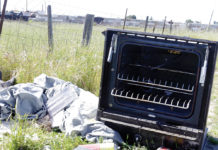
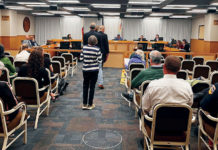
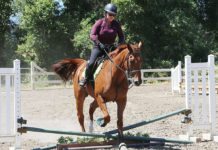





I was glad to learn about Watsonville Wetlands Watch free tree give away in 2021. Since then, my fellow Pajaro Village neighbors, Robin Russell, Lori Deal and I have gone door to door in Pajaro Village to promote this program.
Trees breathe OUT oxygen. they sequester carbon dioxide, one of the main factors in global climate change.
Don’t be like idiot Herschel Walker, who said: “don’t we have have enough trees around here?” (one of the many reasons he lost the GA senate race). NO, we do NOT have enough trees around here.
Contact WWW and schedule a tree, of your choosing, to put in your yard this week. Do your neighborhood, our city, the state , the nation and our planet a favor.
The WWW has done a great job of promoting their excellent program. I would hope that you and your neighbors who believe in the program, would pick up the shovels and dig the holes and plant the trees and then take care of those trees all over the city, and not go around & tell your neighbors what you think they should to do. That would be a good use of your time and energy and show respect to your city.